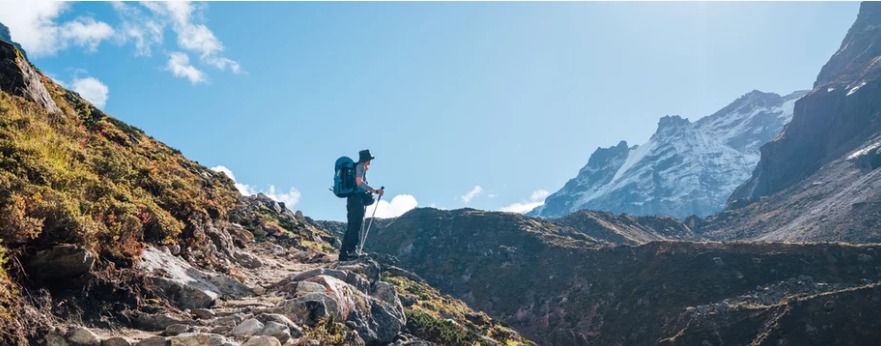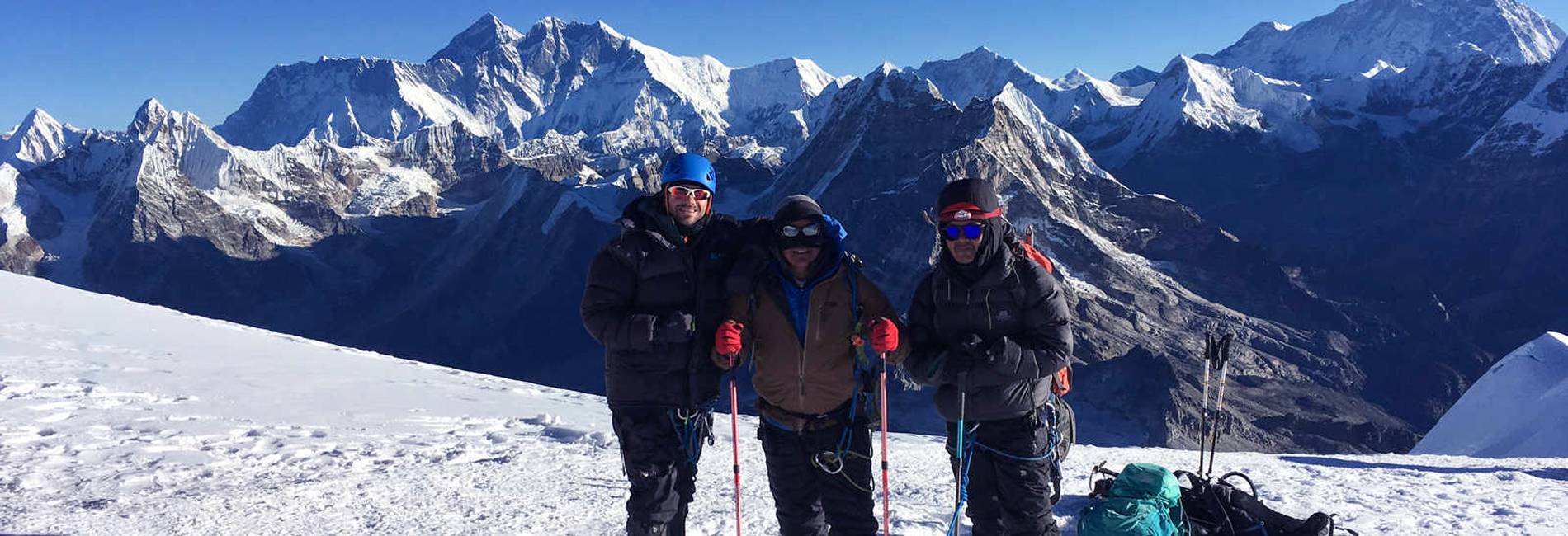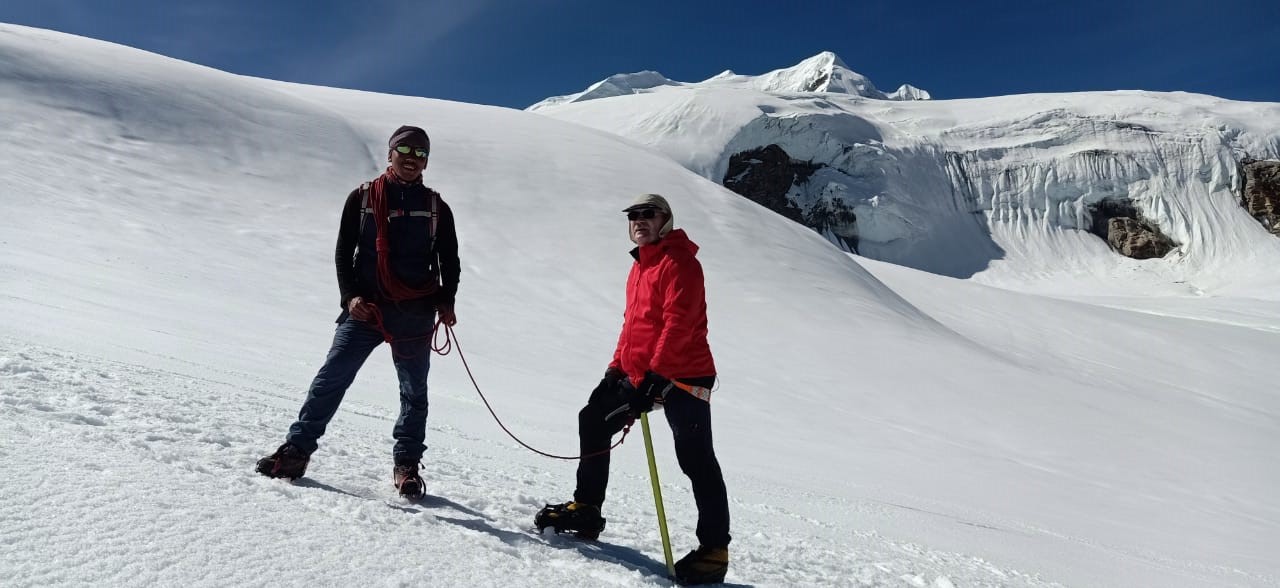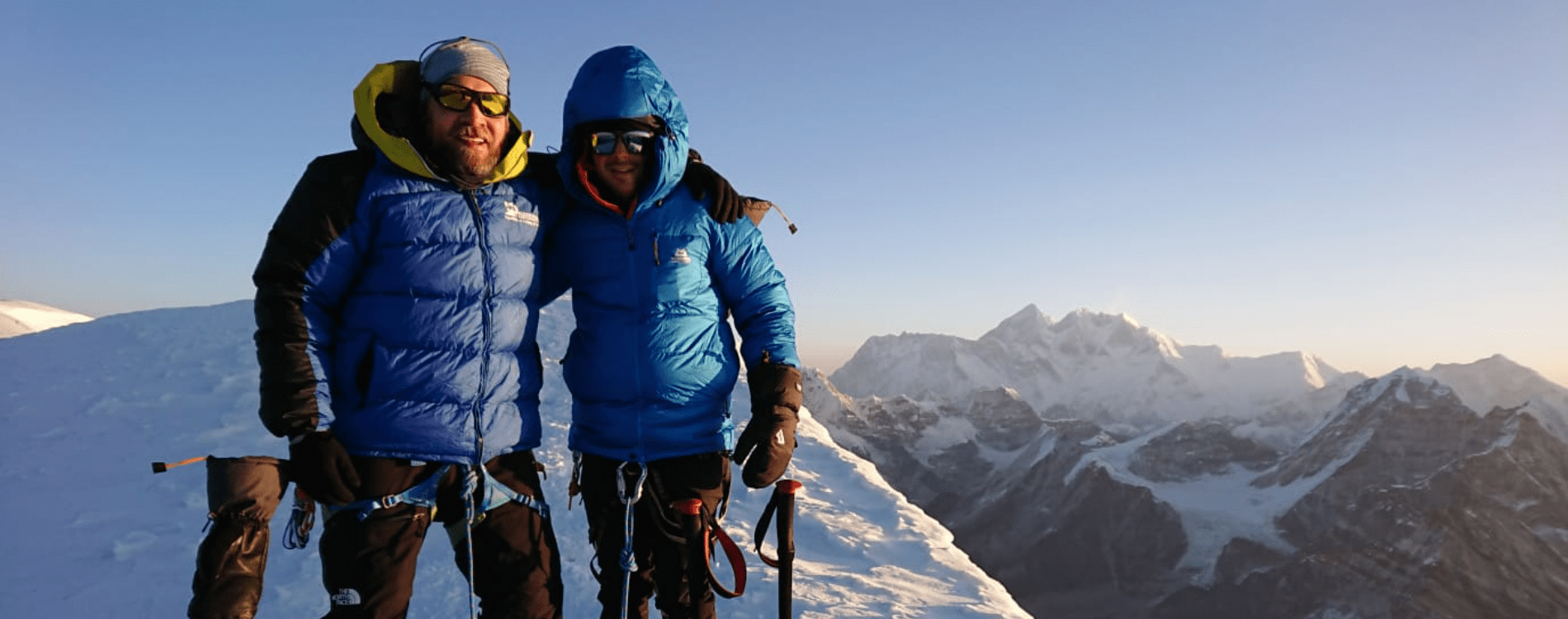26th August, 2025

Mar 01, 2024
Mera Peak Climbing in June
- Why Should You Climb Mera Peak in June
- Mera Peak Weather, Climate, and Temperature in June
- Advantages to Climb Mera Peak in June
- What Should I Pack for Mera Peak Climbing in June
- How Can We Choose the Best Expedition Company and Guide Like Sherpa Expedition
- Is Mera Peak Suitable for Beginner Climbers
- Who Can Provide Us with Training Before Summiting Mera Peak
- Why Choose Sherpa Expedition Guide for Summiting Mera Peak
- Mera Peak Climbing Permit and Cost
- Why Sherpa Expedition Has Everyday Availability for Mera Peak Climbing
- Preparation and Safety About Mera Peak
- Altitude Sickness and Acclimatization
- Conclusion
- Mera Peak Climbing Packages
Climbing Mera Peak in June offers a thrilling adventure amidst Nepal's stunning Himalayan landscape. As the highest trekking peak in Nepal, Mera Peak stands at 6,476 meters (21,246 feet) and presents an exciting challenge for mountaineers and trekkers alike.
June marks the beginning of the monsoon season in Nepal, bringing warmer temperatures and occasional rain showers to the region. While this can mean some cloud cover and precipitation, it also brings lush greenery to the lower valleys, creating a beautiful contrast against the snow-capped peaks.
The climb typically begins with a scenic flight from Kathmandu to Lukla, followed by a trek through picturesque Sherpa villages, dense rhododendron forests, and high-altitude landscapes. Along the way, trekkers can immerse themselves in the local culture, visiting monasteries and interacting with Sherpa communities known for their hospitality.

MERA PEAK CLIMBING
Mera Peak Climbing is an exhilarating adventure in Nepal that gives you an opportunity to reach the summit of Mera Peak at more than 6400m above sea level. Actually, it is the highest climbing (w...
As climbers ascend towards Mera Peak Base Camp, the landscape transforms into a rugged alpine environment, offering stunning views of towering peaks such as Everest, Lhotse, and Makalu. The route to the summit involves navigating crevassed glaciers and using basic mountaineering skills, including the use of crampons and ice axes.
June is considered a viable month for climbing Mera Peak despite the onset of the monsoon. Clear weather windows can still be found, especially earlier in the month, offering good visibility and ideal climbing conditions. However, it's essential to be prepared for variable weather and to plan the climb with experienced guides who understand the local conditions.
Reaching the summit of Mera Peak is a rewarding experience, providing panoramic views of some of the world's highest mountains and a sense of achievement for climbers. Descending back through the valleys in June allows trekkers to witness the changing landscapes once more, as the monsoon rain revitalizes the surrounding flora and creates spectacular waterfalls.
Overall, Mera Peak climbing in June combines adventure with natural beauty, making it a memorable journey for those seeking a challenging yet fulfilling Himalayan expedition.

MERA PEAK EXPEDITION 14 DAYS
The Mera Peak Expedition is a 14-day trek that offers a unique and challenging route to the summit of Mera Peak. The Upper Route is a less-traveled path that takes you through some of the most remote...
Why Should You Climb Mera Peak in June
June offers a unique opportunity to climb Mera Peak due to several factors. Despite being the beginning of the monsoon season in Nepal, June still provides favorable conditions for climbers. The weather is relatively stable earlier in the month, with clear skies and good visibility for enjoying breathtaking views of the Himalayan peaks. The lush greenery and blooming rhododendrons add to the scenic beauty, enhancing the trekking experience. Additionally, fewer climbers on the trail mean a quieter and more serene journey, allowing for a more intimate connection with the stunning surroundings and local culture. For those seeking adventure off the beaten path while still enjoying reliable weather windows, June presents an excellent option for tackling Mera Peak.
Mera Peak Weather, Climate, and Temperature in June
June in the Mera Peak region of Nepal experiences the transition into the monsoon season. The weather can be variable, with early June typically offering clearer skies and more stable conditions before the onset of heavier rainfall later in the month. Daytime temperatures at lower elevations range from mild to warm, ideal for trekking, while nights can be cooler, especially at higher altitudes.
Temperatures at Mera Peak Base Camp and above vary depending on altitude, but generally range from mild to cold, requiring adequate clothing and gear. Rain showers are common, particularly in the afternoons and evenings, although they tend to be brief and followed by clear spells. The landscape is lush and green, adorned with blooming flowers and vibrant foliage, creating a picturesque setting for trekking and climbing. Experienced guides are essential to navigate the weather fluctuations and ensure a safe and enjoyable expedition during this transitional period.

MERA PEAK EXPEDITION 13 DAYS
Mera Peak is one of the most popular and highest trekking peaks in Nepal, standing at 6,476 meters. The Mera Peak expedition is a 13-day trek that takes you through some of the most breathtaking scene...
Advantages to Climb Mera Peak in June
Climbing Mera Peak in June offers several advantages for adventurers seeking a unique Himalayan experience. The quieter trails allow for a more peaceful and personalized journey, with fewer climbers on the route compared to peak trekking seasons. This enhances the sense of solitude and connection with nature, particularly in the serene alpine environment.
Despite the onset of the monsoon, June still presents favorable weather windows with clear skies and good visibility earlier in the month, ideal for summiting Mera Peak and enjoying panoramic views of Everest, Lhotse, and Makalu. The landscape is rejuvenated by the monsoon rains, creating lush green valleys and cascading waterfalls that add to the natural beauty of the trek.
Climbers can also experience the rich Sherpa culture along the way, visiting local monasteries and villages while benefiting from the warmth and hospitality of the Sherpa people. Overall, June provides a balance of adventure and natural splendor, making it a rewarding time to embark on the challenge of climbing Mera Peak.
What Should I Pack for Mera Peak Climbing in June
Packing for Mera Peak climbing in June requires careful consideration due to variable weather conditions. Essential items include high-quality trekking gear such as waterproof and windproof jackets, insulated layers, sturdy hiking boots, and trekking poles. Pack a warm sleeping bag suitable for sub-zero temperatures at higher altitudes and a good quality backpack for carrying your gear. Sunscreen, sunglasses, and a wide-brimmed hat are crucial for sun protection, while a headlamp and spare batteries are essential for early morning starts and evening hikes. Don't forget to pack a comprehensive first aid kit, including altitude sickness medication and personal medications, as well as snacks and hydration supplies for energy on the trail. Lastly, carry appropriate climbing equipment such as crampons, ice axes, and harnesses, depending on your climbing itinerary. Packing smartly ensures you're prepared for both the challenges and the beauty of Mera Peak in June.

MERA PEAK CLIMBING 17 DAYS
This is an excellent opportunity to climb Nepal’s highest peak without having to obtain a permit (6,476m/21,190ft). From the summit, you will have stunning views of several 8000m plus peaks, such as E...
How Can We Choose the Best Expedition Company and Guide Like Sherpa Expedition
Choosing the best expedition company and guide for Mera Peak involves thorough research and consideration of several factors. Look for companies with a solid reputation and experience in organizing Himalayan expeditions, specifically climbing Mera Peak. Check reviews and testimonials from past clients to gauge their satisfaction and safety record.
Ensure the company employs experienced guides who are certified by relevant authorities and familiar with the local terrain and culture. A good guide can enhance your experience by providing expert knowledge, ensuring safety protocols are followed, and offering support throughout the expedition.
Verify that the expedition company provides comprehensive services, including transportation, accommodation, meals, permits, and emergency evacuation plans. Clear communication regarding itinerary, costs, and inclusions is crucial to avoid any misunderstandings.
Choosing Sherpa Expedition ensures you're partnering with a reputable company known for their expertise in organizing climbs like Mera Peak. Their Sherpa guides bring invaluable local knowledge and cultural insights, enhancing your trekking experience while prioritizing safety and sustainability. Ultimately, selecting the right expedition company and guide is key to a successful and memorable Mera Peak climbing adventure.
Is Mera Peak Suitable for Beginner Climbers
Mera Peak is considered one of Nepal's easier trekking peaks, making it suitable for novice climbers with the right preparation and guidance. While previous trekking experience at altitude is beneficial, technical climbing skills are not mandatory. However, climbers should be physically fit and prepared for long days of trekking at high altitude, which can be physically demanding.
The climb to Mera Peak involves walking on snow and glacier terrain, which requires the use of crampons, ice axes, and ropes. Basic mountaineering skills and familiarity with using this equipment are necessary, although they can be learned during the expedition with guidance from experienced Sherpa guides.
Overall, while Mera Peak is achievable for beginners with proper training and guidance, it's important to assess your fitness level and comfort with high-altitude trekking and basic mountaineering techniques before embarking on this adventure.

MERA PEAK CLIMBING 15 DAYS
The Mera Peak Expedition is a 15-day trek that takes you through some of the most stunning landscapes and challenging trails in Nepal. Mera Peak is the highest trekking peak in Nepal, standing at 6,47...
Who Can Provide Us with Training Before Summiting Mera Peak
Before summiting Mera Peak, it's advisable to undergo training to prepare physically and mentally for the challenges of high-altitude trekking and basic mountaineering. Several options are available to receive training:
Local Trekking Agencies: Many trekking agencies in Kathmandu and Lukla offer pre-climb training programs that cover essential skills like using crampons, ice axes, and rope techniques.
Mountaineering Schools: Consider enrolling in a mountaineering course offered by reputable schools in your home country or in Nepal. These courses provide comprehensive training in mountaineering skills, safety protocols, and acclimatization strategies.
Guides and Sherpas: Experienced Sherpa guides accompanying you on the expedition often provide on-the-spot training during the climb itself. They will teach you how to use climbing equipment effectively and safely navigate the mountain terrain.
Training should include physical conditioning through aerobic exercises, strength training, and hiking with a loaded backpack to simulate the conditions you'll encounter on Mera Peak. Acclimatization strategies are also crucial to minimize the risk of altitude sickness and ensure a successful summit attempt.
Why Choose Sherpa Expedition Guide for Summiting Mera Peak
Choosing Sherpa Expedition for summiting Mera Peak ensures you benefit from their extensive experience, local knowledge, and commitment to safety and sustainability. Sherpa guides are renowned for their expertise in Himalayan climbing and deep cultural understanding, enriching your trekking experience with insights into local customs and traditions.
Sherpa Expedition employs certified guides who have undergone rigorous training and are familiar with the terrain, weather patterns, and altitude challenges of Mera Peak. They prioritize safety at all times, ensuring proper acclimatization, monitoring health conditions, and providing emergency support if needed.
Additionally, Sherpa Expedition offers comprehensive services including transportation, permits, accommodation, meals, and equipment rental, streamlining your expedition logistics and allowing you to focus on enjoying the journey. Their personalized approach and dedication to client satisfaction make them a trusted choice for climbers seeking a memorable and successful summit of Mera Peak.

Mera Peak Climbing 20 Days
This is a chance to go climbing without the necessary permits that most climbing expeditions require in Nepal. Mera Peak fits the bill perfectly and at (6,476m/21,190ft) you will have spectacular view...
Mera Peak Climbing Permit and Cost
Climbing Mera Peak requires obtaining the necessary permits from the Nepal Mountaineering Association (NMA). As of recent updates, the permit cost for Mera Peak is around USD 700 per person for foreign climbers, which includes the peak fee, garbage deposit, and other administrative charges. Additionally, trekkers need the Sagarmatha National Park entry permit and local area permits, which add to the overall cost.
It's essential to apply for these permits through a registered trekking agency like Sherpa Expedition, ensuring compliance with local regulations and conservation efforts. The permit fees contribute to maintaining the trails, preserving the environment, and supporting local communities.
Why Sherpa Expedition Has Everyday Availability for Mera Peak Climbing
Sherpa Expedition's everyday availability for Mera Peak climbing is attributed to their extensive network, experienced guides, and efficient logistics management. They maintain a flexible schedule and operate multiple expeditions throughout the season, accommodating varying trekker preferences and ensuring optimal weather conditions.
Their experienced Sherpa guides are intimately familiar with the Mera Peak route and local conditions, enabling them to adapt quickly to weather changes and ensure safety. Sherpa Expedition prioritizes client safety and satisfaction, offering personalized itineraries, thorough acclimatization schedules, and comprehensive support throughout the journey.
Choosing Sherpa Expedition means access to expert guidance, reliable equipment, and well-planned logistics, ensuring a memorable and successful climb of Mera Peak.
Preparation and Safety About Mera Peak
Preparing for Mera Peak involves physical fitness training, mental readiness, and understanding the challenges posed by high-altitude trekking and climbing. Sherpa Expedition emphasizes thorough preparation with comprehensive briefing sessions, equipment checks, and personalized training in mountaineering techniques.
Safety measures include regular health checks, emergency evacuation plans, and adherence to strict altitude acclimatization protocols. Sherpa Expedition's experienced guides monitor climbers' health and provide guidance on managing altitude sickness symptoms, ensuring a safe ascent and descent.
It's crucial to pack essential gear, including warm clothing, climbing equipment, and personal medications. Training hikes and physical conditioning are recommended to enhance endurance and prepare for the demanding trek to Mera Peak Base Camp and beyond.

MERA PEAK SUMMIT RETURN BY HELICOPTER
Mera Peak Climbing Just in 12 Days Return By Helicopter to Lukla and flight back Kathmandu.This is an excellent opportunity to climb Nepal’s highest peak without having to obtain a permit (6,476m/21,1...
Altitude Sickness and Acclimatization
Altitude sickness, or acute mountain sickness (AMS), is a common concern when climbing Mera Peak due to its high altitude. Symptoms can range from mild headaches and nausea to more severe conditions like High Altitude Pulmonary Edema (HAPE) and High Altitude Cerebral Edema (HACE).
Sherpa Expedition prioritizes acclimatization with carefully planned itineraries that include gradual ascent and rest days at strategic points. This allows climbers to adjust gradually to higher altitudes, reducing the risk of AMS. Guides monitor climbers' health closely and provide guidance on hydration, nutrition, and managing symptoms.
It's essential for climbers to recognize early signs of AMS, stay hydrated, avoid alcohol and smoking, and communicate openly with guides about any discomfort. Sherpa Expedition's experienced team ensures climbers' safety and well-being throughout the expedition, prioritizing a successful summit while maintaining health and safety standards.
Conclusion
Climbing Mera Peak with Sherpa Expedition offers adventurers a unique blend of challenge, adventure, and cultural immersion in the breathtaking Himalayan landscape. From obtaining permits and preparing for the climb to ensuring safety and acclimatization, Sherpa Expedition's expertise and commitment to excellence shine through every aspect of the journey.
With everyday availability, personalized itineraries, and experienced Sherpa guides, Sherpa Expedition provides a reliable and enjoyable experience for climbers of all levels. Whether summiting a peak for the first time or seeking a new adventure in Nepal, choosing Sherpa Expedition ensures a memorable and successful expedition to Mera Peak, leaving climbers with lifelong memories of the majestic Himalayas.

MERA PEAK SUMMIT 10 DAYS
This is a chance to go climbing without the necessary permits that most climbing expeditions require in Nepal. Mera Peak fits the bill perfectly and at (6,476m/21,190ft) you will have spectacular view...
Mera Peak Climbing Packages
Mera Peak Summit Return By Helicopter

ISLAND PEAK CLIMBING
Sherpa Expedition & Trekking (Est.1977) are pleased to announce FOR ADVENTURERS the most awesome, exhilarating & unforgettable climbing and treks on offer anywhere today!...
Any Questions? Let Us Know.
Recent Posts
17th June, 2025


















